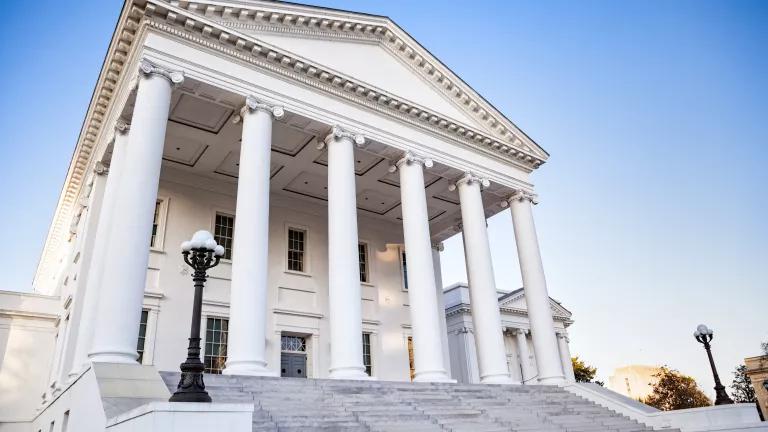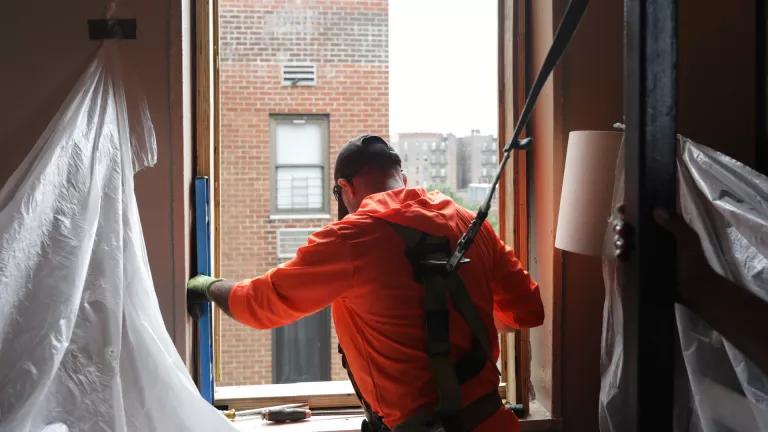What's Next on Even Bolder Climate Action in Virginia
With climate leaders now back in control of the statehouse, here's what they'll deliver in the next 2 years to keep Virginia's national leadership on track

Climate leaders in Virginia's capitol are poised to take major climate strides in 2024 & 2025, with decisive fossil fuel pollution reductions from buildings, power plants, and cars, climate solutions that will also slash consumer costs to everyday Virginians.
Climate leaders are back in control of the statehouse in Richmond. And that is very good news.
Because the last time there was a climate-action majority in Virginia’s House and Senate chambers (2020-2021), the Commonwealth took a truly great leap forward on addressing the climate change that, already today, uniquely threatens Virginia, its economy, and Virginians’ safety. Virginia’s climate action in 2020 and 2021 was bolder than any American state has taken in so short a time, both before and since. In those two short years, Virginia leapt from the back of the pack to the very front among climate leadership states.
Virginia’s climate leaders, now back in possession of the capitol, delivered 2020-2021 climate action in three key ways:
First, climate champs in Richmond ensured a keystone source of air pollution and climate harm in Virginia – fossil fueled power plants – steadily cut down their pollution year over year. The Regional Greenhouse Gas Initiative (RGGI) also makes those biggest air-polluters recompense Virginia for the climate harms they cause (also known as “internalizing” the costs of pollution), rather than foisting off, or “externalizing,” the climate costs of air pollution on the rest of us. The market based program to encourage shifting from costly fossil fuels over to cheaper renewables and, ideally, energy efficiency, has worked, with pollution steadily decreasing since the program's inception.
At the same time, Virginia invests those climate-damage payments from polluters. Those funds go toward equitable investment in bill-lowering energy efficiency improvements in the homes of our less affluent neighbors. The second portion wisely goes toward strengthening Virginia's resilience against the sea level rise and extreme flooding.
To date, polluters have paid Virginia close to $1 billion, even as their smokestacks no longer belch unlimited pollution into the air that you and I breathe.
But Virginia’s climate leaders weren’t done yet!
Second in Virginia’s great-leap-forward on climate was the passage of the “Clean Cars Virginia” law. That climate solution ensures we begin to address our single largest source of pollution – transportation – by ensuring Virginians have equal, adequate access to increasingly-in-demand zero pollution electric vehicles (EVs).
Virginia is the only state in the south to choose to join the over 1 in 5 American states that have adopted this off-the-shelf pollution solution under the federal Clean Air Act.
And the benefits of the program don’t stop with cleaner air: EVs are far cheaper to fuel up and own (and much more fun to drive) than gas-guzzling, pollution-belching cars. Even better, Virginians fueling up at the electrical socket with Virginia-produced energy will keep our driving dollars in state and in our own electric grid, rather than be sent out of state to pay for imported oil.
And third in the Richmond climate victories is the passage of the Virginia Clean Economy Act (VCEA). By some measures the single most forward-leaning climate measure in the nation, the VCEA guides Virginia to a carbon-free power supply by mid-century. It does so through record investment in what will be the world’s largest offshore wind farm, record-setting levels of solar energy, and one of the biggest commitments to battery storage in the nation, to help soak up all those clean electrons.
As we slash pollution under RGGI, the VCEA in turn ensures the dirty energy supply of the past is replaced by the clean energy sources of today and tomorrow.
Virginia’s Climate Leaders Didn’t Just Play Offense: They Were Also a Brick Wall
Following on the best-in-the-nation climate leadership of 2020 and 2021, Virginia leaders continued to light the way in 2022 and 2023.
That's when, inexplicably, Gov. Glenn Youngkin made sloppy, reckless attacks on Virginia’s popular climate laws, making his pro-pollution destruction a centerpiece of his ugly culture-war agenda. Yet despite robotically and fecklessly doing the bidding of yesteryear’s Big Polluters, climate leaders running the Virginia Senate stood strong. Youngkin-incited attacks on Clean Cars, RGGI, and the VCEA all floundered and died at the legislature, as the Senate brick wall rebuffed Youngkin, again and again.
And as a result, climate leaders returned to power in 2024.
What’s Next for Virginia’s Climate Leaders in 2024 & 2025
By holding the climate line in 2022 and 2023 against Youngkin’s fruitless, wasteful climate attacks, they are in an excellent starting point for further action in 2024 and 2025.
Something as vexing and far-reaching as the climate crisis cannot be solved in two short years, bold as Virginia’s climate action in ’20 and ’21 was. Much work remains to be done, upon Virginia's very solid foundation.
Here’s what needs to happen next:
1). SCC appointments
One of the most important bodies in Virginia for climate action, the State Corporation Commission oversees much of our economy’s transition to clean energy. However, in the past that body has been overly-focused on greenlighting overly-expensive and polluting fossil fuel plants, and antagonistic to commonsense climate solutions like energy efficiency.
With two open seats, the legislature has a once-in-a-lifetime opportunity to ensure the SCC guides Virginia’s economy in a sensible, climate-friendly way. The legislature therefore must appoint two commissioners with expertise in clean energy solutions and the good sense that cost-saving resources like energy efficiency, electrification, and EV-charging are at the forefront of Virginia’s climate solutions.
2). Boosting Energy Efficiency
Electric utilities have very successful and effective energy efficiency programs to lower both ratepayer bills and upstream power-plant pollution. Things like better insulation, upgraded ductwork and HVAC, and modern lighting, when installed, slash costs and pollution across the Commonwealth.
However, largely due to senseless restrictions put upon them by their regulators at the State Corporation Commission (SCC), only a mere 4% of Virginia ratepayers benefit from those cost-saving efficiency programs from Virginia’s largest utility.
Climate leaders must increase that number 10-fold, to lower pollution in a way that also lowers Virginians' increasing costs-of-living.
2). Cutting Building Pollution
Dirty fossil fuels in buildings, especially oil and propane tanks, release a whopping 15% percent of Virginia’s climate-changing carbon pollution. Richmond leaders must begin to phase out the burning of fossil fuels inside our buildings through a simple means, one that will also slash energy bills: the installation of high-efficiency heat pumps, to cool and heat our homes and businesses. Far cheaper electricity not only saves money, it’s also a homegrown domestic energy supply from increasingly clean sources.
Our electrical utilities should be the legislature’s primary partner in ensuring these efficient heat pumps are installed across the state, especially by taking advantage of cost-saving federal rebates, and through the utilities’ low-income energy efficiency programs.
3). Comprehensive Pollution Solutions for Virginia’s Biggest Air Polluter: Transportation
Richmond leaders have for far too long mindlessly thrown money at gridlock- and pollution-worsening highway construction. A truly modern economy should move people and goods about in better-designed towns and countryside, with a wealth of proven transit options, including walking safely. Instead, Virginia leaders have ensured we sit in endless, polluting traffic.
Climate leaders must therefore finally reform how taxpayers fund our transportation system, to bring our priorities away from the Eisenhower era, and instead into the 21st century.
Richmond leaders must also ensure our increasingly electric car fleet has access to EV-charging all across the state, especially through utility programs that lower the costs of driving and the costs of the power grid for everyone.
If Richmond’s climate leaders knock these four items out in 2024 and 2025, Virginia will take its second-in-a-row great leap forward into a safer, more prosperous climate future.




